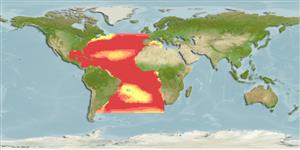Classificação / Names
Common names from other countries
Referência principal
Tamanho / Peso / Idade
Max length : 500 cm TL macho/indeterminado; (Ref. 11441); 500.0 cm TL (female); common length : 290 cm TL macho/indeterminado; (Ref. 6659); Peso máx. publicado: 636.0 kg (Ref. 40637); Peso máx. publicado: 636.0 kg
Length at first maturity
Lm ?, range 50 - ? cm
Ambiente
; marinhas; oceanódromo (Ref. 51243); intervalo de profundidade 0 - 200 m (Ref. 43)
Clima / Intervalo
Subtropical; 22°C - 31°C (Ref. 43), preferred 27°C (Ref. 107945); 50°N - 45°S, 98°W - 17°E (Ref. 43)
Distribuição
Atlantic Ocean: in tropical and temperate waters. We follow Nakamura 1985 (Ref. 43) in recognizing Makaira mazara and Makaira nigricans as two distinct species chiefly because of differences in the pattern of the lateral line system. Many scientists, however, do not recognize this character as specifically diagnostic and consider the latter species as a single pantropical species occurring in the Atlantic, Pacific and Indian oceans. Highly migratory species, Annex I of the 1982 Convention on the Law of the Sea (Ref. 26139).
Países | Áreas FAO | Ecossistemas | Ocorrências | Introduções
Descrição breve
Espinhos dorsais (total): 0; Raios dorsais moles (total): 45-50; Espinhos anais 0; Raios anais moles: 19 - 23. Body blue-black above and silvery white below, with about 15 rows of pale cobalt-colored stripes; 1st dorsal fin plain blackish or dark blue, other fins brown black with a tinge of dark blue in some specimens; anal fin bases with a tinge of silvery white. Lateral line a network of interconnecting canals (Ref. 26938).
Categoria na Lista Vermelha da IUCN (Ref. 115185)
Ameaça para o homem
Harmless
Utilização humana
Pescarias: espécies comerciais; peixe desportivo: sim
Mais informação
ReferênciasAquaculturaPerfil para aquaculturaEstirpesGenéticaFrequência dos alelosHereditariedadeDoençasProcessamentoMass conversion
Ferramentas
Relatórios especiais
Descarregue XML
Fontes da internet
Estimates of some properties based on models
Phylogenetic diversity index
PD50 = 0.7505 many relatives (e.g. carps) 0.5 - 2.0 few relatives (e.g. lungfishes)
Nível Trófico
4.5 ±0.3 se; Based on diet studies.
Resiliência
Médio, tempo mínimo de duplicação da população 1,4 - 4,4 anos (K=0.1-0.3)
Vulnerabilidade
Moderate to high vulnerability (52 of 100)
Categoria de preço
